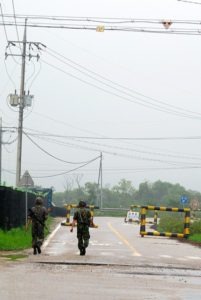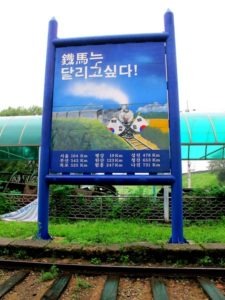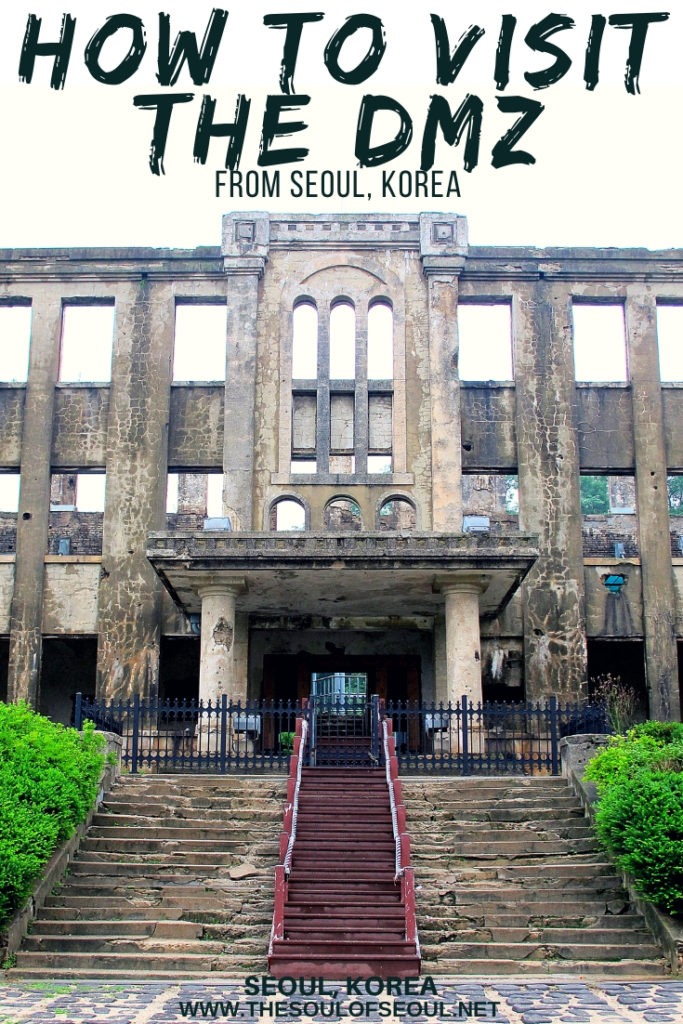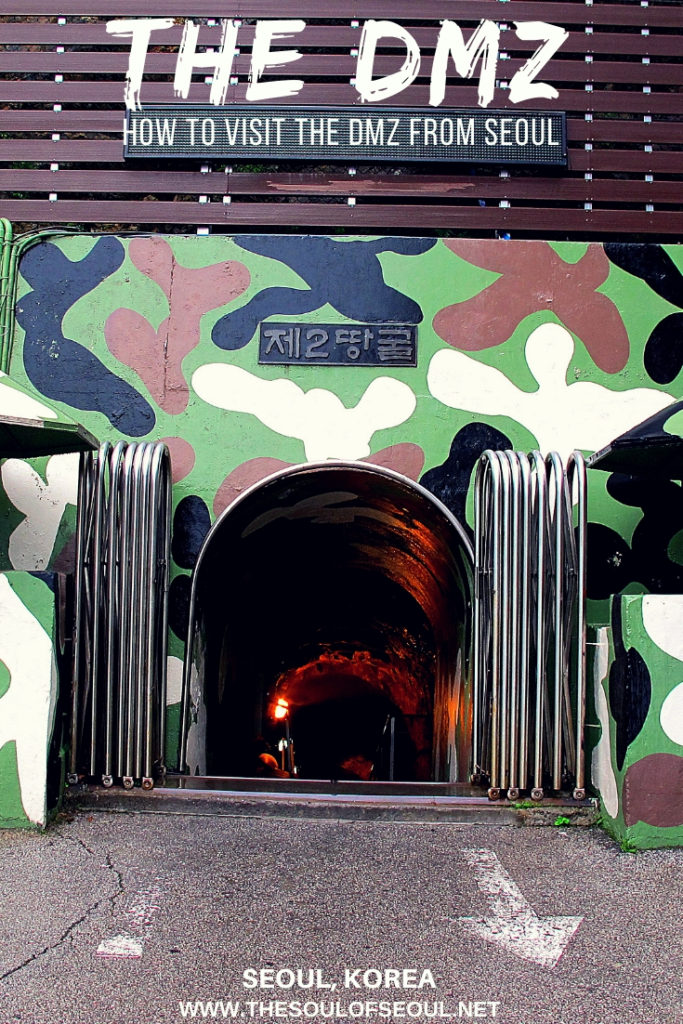How To Visit The The Cheorwon DMZ Area From Seoul, Korea
Last Updated on December 16, 2023
Most tourists that visit Seoul, Korea wonder if they can fit in a trip to the DMZ at some point. The areas that are open to tourists are centered around the tunnels that the North Koreans built as they tried to sneak into South Korea some decades ago. The most often visited by tourists and easiest to access is the DMZ area in the Paju region. While this is an easy spot to get to, it’s a bit too touristy for my liking. Though the trek to get to Cheorwon, Korea is a bit more tough, there is a completely different experience.

Want to know how to visit the DMZ from Seoul, Korea? Let me get you to the Cheorwon DMZ area centered around the second underground tunnel for an experience you won’t forget.
(This post contains affiliate links, which means I receive a certain percentage of a sale if you purchase after clicking. These funds go to maintain the site. Thank you for your support.)
How To Get There
Getting two and from Cheorwon is not the easiest trek and the bus from Seoul stops a lot which makes the trip that could take two hours, three hours.
Cheorwon Facilities Management Office formerly Iron Triangle Tourist Office (철원 시설물관리사업소 (구 철의삼각전적관)) is where the tours into the area begin from.
Address: 1825 Taebong-ro, Cheorwon-gun, Gangwon-do (강원도 철원군 동송읍 태봉로 1825)
Directions from Seoul: Bus from Express Bus Terminal to Uncheon Bus Terminal (운천버스터미널) The ride takes about 3 hours. After arrival, catch a taxi to Goseokjung (고석정).
Join a tour: For the tour from the Iron Triangle Tourist Office, visitors also need to have their own car or hire a taxi that has the proper permits to go through the gates. Basically, there are quite a few logistics to figure out and time that is required. If you don’t want to figure it all out on your own like we did, definitely join a tour. Here are some good options:
Join a tour with Klook: Get picked up in central Seoul and visit the Memorial Tower, Baengmagoji Battlefield and Memorial Museum. From there, see the 2nd Tunnel, Cheorwon Peace Observatory, the Woljeong-ri Station, and the other important stops in the area. It’s a great tour that hits all of the big spots in one easy day trip.
Join a tour with kkday: kkday offers a tour to Cheorwon to visit the 2nd tunnel and Cheorwon Peace Observatory among other important sites in the area.
Basic Info
Admission: W8,000 (This is the basic fee if you get up to the Iron Triangle Tourist Office and take the tour from there.)
Tour Running Time: 3 hours
Tour Stops: North Korean Labor Party Building, Woljeong-ri Station, Cheorwan Peace Observatory, 2nd Underground Tunnel
Experiencing The DMZ In Cheorwon
Bus from Seoul to Cheorwon
We started out the morning getting an intercity bus from Dong Seoul Terminal outside of Gangbyeon Station. The bus is not your normal intercity bus and stopped every 5-10 minutes or so making what could have been an hour and a half trip on the highway into a three hour journey along the back roads.
Get a driver from the Iron Triangle Tourist Office
By the time we arrived we had 15 minutes to get to the Iron Triangle Tourist Office from the bus terminal. We hopped in a taxi and told the driver of our deadline and he rushed us to the location. Reservations for tours are not necessary however, you must arrive 15 minutes prior to departure to give everyone time to get their cars in line and the tours start right on time at 9:30, 10:30, 1:00 or 2:00.

As we did not have a car and the tour doesn’t provide buses, we hired our taxi driver for the remainder of our journey. I suggest getting a flat rate for the whole trip rather than letting the meter run while on the tour. We managed a rate of W60,000 for three hours, but the meter that he had left running said W90,000 by the end of the trip.


We were off in a caravan of six cars, just us, our guide and some older Korean men in a car up front. The guide provided by the museum is not really a guide that can share stories and tales of the war, but more of your way through all of the checkpoints. An informational packet was provided, so it was fine. She did point out the mine fields along the way though, which was rather unsettling.
2nd Underground Tunnel
Our first stop was the 2nd Underground Tunnel. The tunnel was discovered on March 19th, 1975 after a soldier heard an explosion from beneath the ground. The tunnel is 3.5 kilometers long and sits 50 to 160 meters deep. Hard hats were provided and we descended. It was wet and dark like most underground caverns and along the way we could see holes that the engineers had made to the surface so they could see above. At the very end there are mannequins dressed up in uniforms and cameras to monitor that no one tries to go any further.


Woljeong-ri Station
A couple stops later, we headed to Woljeong-ri Station. The information provided explained that this name means the moon and the well and there once lived a girl and her sick father here. She prayed every night for her father to get well once again and one night she dreamed that by giving him water from a nearby well his health would improve. The only condition was that she had to take the water to him using only her hands and it should be done 1000 times before the moon set. Eventually, she completed this task and saved her father, but in so doing lost her life from the hard work. The town was named in her memory. There’s a small statue in front of the station to remember her, but other than that the station is not as beautiful as the story.


The building is just the shell of what it once was, a stop on the Seoul-Gangwon line, but sitting in the back is an old North Korean transport train, bombed by American forces. The women in a group behind us began picking berries growing through the skeleton of the old train and we ate together while thinking about the very recent past in this area. The sign before us read, ‘The iron horse wants to run’, a fitting epitaph for this train that once frequently made trips to North Korea on a line that connected the country.

North Korean Labor Party Building
The last stop on the tour was the North Korean Labor Party Building, built in 1946 and used until the armistice in 1953 by the party. North Korea controlled this area for five years as it falls above the 38th parallel but during the Korean War this area came under the control of South Korea and UN forces and when the armistice was signed was still under the control of the South.

The bullet holes and loss of the ceiling of the building are blunt reminders of the violence this area saw and though there was once a vibrant and large city here, now there are just rice paddies and checkpoints. The violence did not only come from battles that commenced in the area, the building was also notorious for the brutal acts that happened inside.



People used to say ‘anyone who goes in there never comes out unscathed,’ according to the information provided. The building is now a Registered Cultural Asset of Modern Cultural Heritages and every year hundreds of thousands of people, young and old alike, visit to remember and learn.
Did you like this post? Pin It!





2 Comments
Rachel
Hi there! Thank you so much for putting all of this information together. I was looking for an alternative to the Paju DMZ options and your site has been so helpful. I’m going to be in Seoul in a couple weeks with my mum – she’s 70 years, in good health generally speaking but does get tired after walking an hour or so and has a bit of a bum knee. Is the second tunnel too arduous for her? And also, if she doesn’t think she’s able to do it, is it possible for her to wait for the rest of the group to finish or does she need to be with the group at all times? Thanks!
Hallie Bradley
Hi Rachel, Usually at the tunnels, the guides will ask people if they can/are able to get down and back up on their own. Anyone who can’t, should wait at the top. The local guide will be able to help you determine if it’ll be too arduous for your mom and her abilities I’m sure. Good luck with your trip!